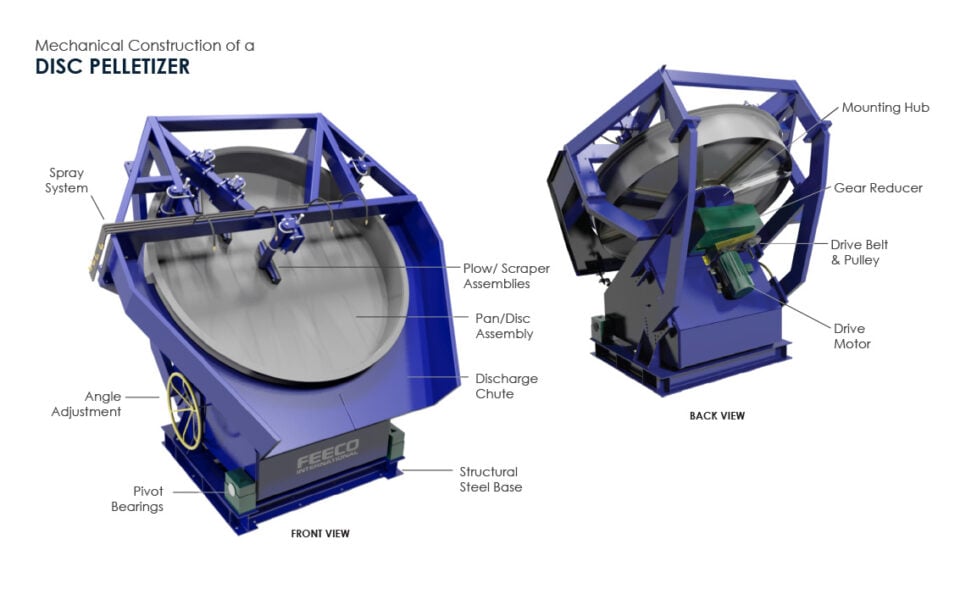In the world of agitation agglomeration equipment, the disc pelletizer (sometimes also called a pan granulator) is often chosen for its ability to create a refined product. It is widely used to process everything from chemical powders, fly ash, and soil amendments, to minerals and ores, fertilizers, and more.
Part of what makes disc pelletizers so successful is that they allow operators to adjust several variables during production in order to fine-tune product size and quality, whether that be to respond to changes in feedstock, or make adjustments to the characteristics of the product discharging from the disc.
This high level of flexibility has led to some confusion around how these machines work. What follows is an explanation on how to use a disc pelletizer.
Disc Pelletizer Construction

The image above illustrates the mechanical construction of a disc pelletizer. The unit is made up of a rotating disc positioned on a stationary steel base. A spray system is mounted over top of the disc pelletizer for binder and liquid additive distribution. Plows or scrapers help to direct self-classifying streams of pellets as the disc rotates.
A raised frame positioned around the rotating disc serves as the discharge chute. For a more detailed overview of disc pelletizer construction and components, see our article, Anatomy of a Pelletizer.
Disc Pelletizer Basics
Disc pelletizers are a “tumble growth” or agitation agglomeration device, meaning they rely on a liquid binder and motion to form and refine agglomerates. The disc pelletizer may be used alone, or in combination with a mixer, most often a pin mixer.
Material is continuously fed onto the disc/pan, where it is taken up by the rotation. The spray system mounted over top of the disc has several moveable spray nozzles (the number of which is determined during the design phase) which spray binder over the material, causing it to become tacky.
This tackiness, and the continuous passing of the material through the feed stream as the disc rotates, causes particles to aggregate together. As the aggregated particles continue to tumble around the disc, they pick up additional layers in a growth pattern known as coalescence. During this process, the pellets become more dense and refined, because the interstices, or spaces between the gathered particles, are filled with smaller particles, and the interstices between those filled with yet smaller particles, and so on.
When a mixer precedes the disc pelletizer, the action is the same, but the pelletizer is instead fed with “seed pellets” or starting nuclei onto which the additional layers of fines are added.
Due to the centrifugal force on the disc, pellets self-classify into streams based on their size; small seed pellets find their way to the right side of the disc, and as they grow, work their way to the left, where they are eventually discharged once they reach the desired size (See diagram below).
How to Operate a Disc Pelletizer
Disc pelletizer operation has been likened to a blend of science and art. During the production process, operators can use several variables to control the formation and growth of pellets on the disc, as well as the characteristics of the product. The process of operating a disc pelletizer involves paying attention to upstream processing conditions and knowing how the different variables interact to affect the product coming off the disc. For this reason, disc pelletizer training for operators is essential.
Disc Pelletizer Variables
Operators can use the following variables in conjunction with each other to control the product characteristics and respond to changes in production.
Disc Speed
Disc speed refers to the RPMs, or the rate at which the disc rotates. Speed is adjusted by with a variable frequency drive (VFD), which gives operators greater control over speed adjustment during start-up and shutdown, or times of fluctuation. Speed is the least important variable, and is used only along with angle adjustment to obtain optimum material coverage on the pelletizer (when the spray system is off, material should cover the entire pan).
Disc Angle
Angle of the pan is adjusted by a hand-wheel jacking screw. To an extent, angle and speed adjustments are complimentary. The steeper the angle of the pan, the faster the speed required.
A higher angle will result in less retention time on the pan, yielding smaller pellets, and a lower degree of angle will result in more retention time on the pan, yielding larger pellets, because pellets have more time to go around the pan and collect more particles.
Feed Rate & Location
The feed rate and location are also adjustable. However, in order to maintain product size and quality, feed rate to the pan must be constant. Any upset in feed will result in an upset of the product.
Binder Spray Rate & Location
Binder spray rate, as well as the locations of binder sprays, are also adjustable. Operators can use binder spray rate and location to respond to changes in feed and encourage larger or smaller pellets.
Plow/Scraper Location
When a liquid is sprayed onto the disc and mixes with the powder feed, buildup can start to occur on the pan bottom and side wall. This buildup has to be removed, or the process won’t work correctly. The plows, or scrapers, remove this buildup and create a smooth surface. As mentioned, they also help direct the pellets into their separate streams as they self-classify.
Conclusion
The pelletizer is an incredibly useful tool in the field of agglomeration. The opportunity for adjustments and customization allow for fine-tuning and customization which can yield an extremely high quality product.
FEECO has been a leader in the agglomeration industry since 1951, manufacturing custom disc pelletizers for a wide range of materials. We offer a unique testing facility where we can test the feasibility of pelletizing your material at both batch and pilot scale. For more information, contact us today!




